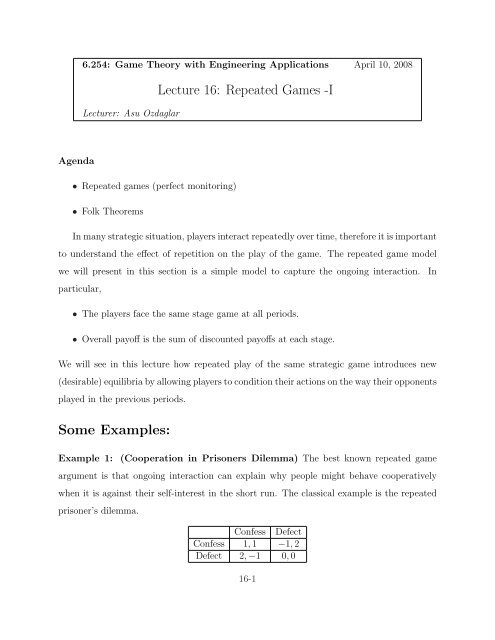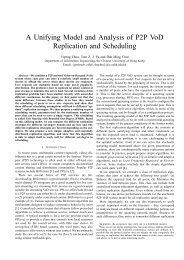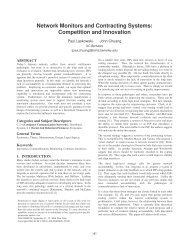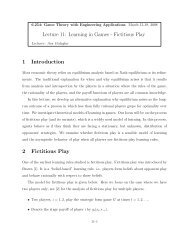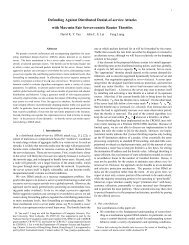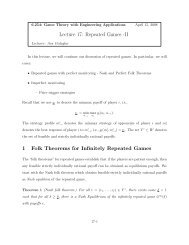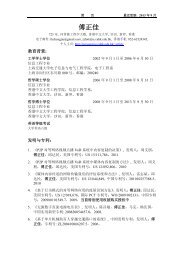Lecture 16: Repeated Games -I Some Examples:
Lecture 16: Repeated Games -I Some Examples:
Lecture 16: Repeated Games -I Some Examples:
Create successful ePaper yourself
Turn your PDF publications into a flip-book with our unique Google optimized e-Paper software.
For this strategic form game, the strategy profile (D, D) is the unique NE. Moreover D<br />
strictly dominates C.<br />
Suppose now the players 1, 2 play the game repeatedly at 0, 1, 2, · · · and the payoff for<br />
the entire repeated game is:<br />
∞∑<br />
u 1 ({a 0 , a 1 }, · · · ) = (1 − δ) δ t g i (a t i, a t −i)<br />
in which δ ∈ [0, 1) →, i.e., players discount the future.<br />
Play once: unique equilibrium → (D, D).<br />
Play it T times: Do backward induction. Again, there is a unique subgame perfect<br />
equilibrium (SPE) in which both players defect in each period.<br />
Now assume that the game is played infinitely often. Is playing (D, D) in every period<br />
still an SPE outcome?<br />
t=0<br />
Proposition 1 If δ ≥ 1 2<br />
every period.<br />
the repeated PD game has an SPE in which (C, C) is played in<br />
Proof: Suppose the players use the “grim trigger” strategy given by the following. For player<br />
i:<br />
I. Play C in every period unless someone plays D, in which case go to stage II.<br />
II. Play D forever.<br />
We next show that the preceding strategy is an SPE if δ ≥ 1 2<br />
principle.<br />
There are two kinds of sub-games:<br />
using the one-stage-deviation<br />
(1) Subgame following a history in which no player has ever defected (i.e., D has never<br />
been played).<br />
(2) Any other subgame (i.e., D has been played at some point in the past).<br />
<strong>16</strong>-2
Consider first a subgame of the form (1), i.e., suppose up to time t, D has never been<br />
played. Player i’s continuation payoffs when he stick with his strategy and when he deviates<br />
for one stage and then conforms to his strategy } thereafter are given respectively by:<br />
Play C : (1 − δ)[1 + δ + δ 2 + · · · ] = 1<br />
=⇒ This shows that for δ ≥<br />
Play D : (1 − δ)[2 + 0 + 0 + · · · ] = 2(1 − δ)<br />
1 deviation is<br />
2<br />
not profitable.<br />
Consider next a subgame of form (2), i.e., action D is played at some point before t. Since<br />
(D, D) is the NE of the static game and choosing C does not have an effect on subsequent<br />
outcomes, it follows that, for any discount factor, no player can profitably deviate by choosing<br />
C in one period. □<br />
Remarks:<br />
1. Depending on size of the discount factor, there may be many more equilibria.<br />
2. If a ∗ is the NE of the stage game, then the strategies “each player, plays a ∗ i ” form an<br />
SPE. (Note that with these strategies, future play of the opponent is independent of<br />
how I play today, therefore, the optimal play is to maximize the current payoff, i.e.,<br />
play a static best response.)<br />
3. Sets of equilibria for finite and infinite horizon versions of the ”same game” can be<br />
quite different.<br />
The following example shows that repeated play can lead to worse outcomes than in the<br />
one shot game:<br />
Example 2:<br />
A B C<br />
A 2, 2 2, 1 0, 0<br />
B 1, 2 1, 1 −1, 0<br />
C 0, 0 0, −1 −1, −1<br />
For the game defined above, the action A strictly dominates B, C for both players, therefore<br />
the unique NE is (A, A).<br />
<strong>16</strong>-3
Proposition 2 If δ ≥ 1 this game has an SPE in which (B, B) is played in every period.<br />
2<br />
Proof Sketch: Here, we construct a slightly more complicated strategy than grim trigger:<br />
I. Play B in every period unless someone deviates, then go to II.<br />
II. Play C. If no one deviates go to I. If someone deviates stay in II.<br />
□<br />
Exercise: Show that the preceding strategy profile is an SPE of the repeated game for δ ≥ 1.<br />
2<br />
General Model<br />
• Let G be a strategic form game with action spaces A 1 , · · · , A I<br />
functions g i : A → R, where A = A 1 × · · · × A I .<br />
and (stage) payoff<br />
• Let G ∞ (δ) be the infinitely repeated version of G played at t = 0, 1, 2, . . ., where players<br />
discount payoffs with the factor δ and observe all previous actions.<br />
• Payoffs for player i:<br />
∞∑<br />
u i (s i , s −i ) = (1 − δ) δ t g i (a i , a −i ).<br />
We now investigate what average payoffs could result from different equilibria when δ is<br />
close to 1. That is, what can happen in equilibrium when players are very patient?<br />
<strong>Some</strong> terminology related to payoffs:<br />
1. Set of feasible payoffs:<br />
V = Conv{v | there exists a ∈ A such that g(a) = v}.<br />
t=0<br />
Example 1:<br />
Consider the following game:<br />
L (q) R (1 − q)<br />
U −2, −2 1, −2<br />
M 1, −1 −2, 2<br />
D 0, 1 0, 1<br />
<strong>16</strong>-4
Let<br />
Sketch set V for this example.<br />
2. Minmax payoff of player i: the lowest payoff that player i’s opponent can hold him to.<br />
v i = min<br />
α −i<br />
[max<br />
α i<br />
g i (α i , α −i )]<br />
m i −i = arg min [max g i (α i , α −i )],<br />
α −i<br />
α i<br />
i.e. minimax strategy profile against player i.<br />
Example 2:<br />
We compute the minimax payoffs for Example 1. To compute v 1 , let q denote<br />
the probability that player 2 chooses action L. Then player 1’s payoffs for playing different<br />
actions are given by:<br />
Therefore, we have<br />
and m 1 2 ∈ [ 1 3 , 2 3 ].<br />
v 1 = min<br />
0≤q≤1<br />
U → 1 − 3q<br />
M → −2 + 3q<br />
D → 0<br />
⎫<br />
⎬<br />
⎭<br />
[max{1 − 3q, −2 + 3q, 0}] = 0,<br />
Similarly, one can show that: v 2 = 0, and m 2 1 = (1/2, 1/2, 0) is the unique minimax profile.<br />
Verify that payoff of player 1 at any NE is 0.<br />
Remark:<br />
1. Player i’s payoff is at least v i in any static NE, and in any NE of the repeated game.<br />
• Static equilibrium: ˆα =⇒ v i = min αi [max αi g i (α i , α −i )] ≤ max αi g i (α i , α −i )<br />
• Extend the above idea for the repeated case.<br />
Check the following: In the Prisoner’s Dilemma example, NE payoff is (0, 0) and minmax<br />
payoff is (0, 0). In the second example introduced in the beginning of the lecture,<br />
NE payoff is (2, 2) and minmax payoff is (0, 0).<br />
We say that a payoff vector v ∈ R I is strictly individually rational if v i > v i for all i.<br />
<strong>16</strong>-5
Folk Theorems: We have observed above that no equilibrium of the repeated game can<br />
go below v i . We next investigate the payoffs that can be obtained at any equilibrium of the<br />
repeated game.<br />
Theorem 1 (Nash Folk Theorem) If (v 1 , . . . , v I ) is feasible and strictly individually rational,<br />
then there exists some δ < 1 such that for all δ > δ, there is a NE of G ∞ (δ) with payoffs<br />
(v 1 , · · · , v I ).<br />
Proof: Assume that there exists an action profile a = (a 1 , · · · , a I ) s.t. g i (a) = v. Recall:<br />
m i −i: minimax strategy of opponent of i<br />
m i i: i’s best response to m i −i.<br />
Now consider the following grim trigger strategy. For player i:<br />
I. Play (a 1 , · · · , a I ) as long as no one deviates (or more than one player deviates). If one<br />
player deviates go to II.<br />
II. If some player j deviates, then play m j i thereafter.<br />
We will complete the proof of this theorem in the next lecture.<br />
□<br />
<strong>16</strong>-6


